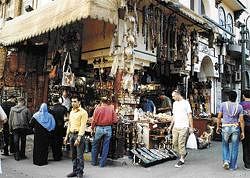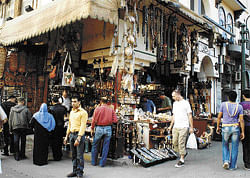

Delhi’s Chandni Chowk and the Khan el Khaleli have the same heady mix of bustle and brash business acumen. We didn’t need a flying carpet to be transported from one bazaar to the other, we’d just have to turn the corner.
Cairo is India-on-the-Nile except that Cairo has more accessible evidence of its ancient past than we have. Our Indus Valley city of Dholavira lies in a distant, saline, wilderness but the Great Pyramid of Khufu, built in 2,500 BC is a powerful presence dominating Cairo even though it is some distance away from the heart of this ancient city.
Traditional beliefs
One morning, we drove out 18 kms to Giza, where the pyramids stand on a desert plateau.. Here we, and hundreds of other visitors, walked to the base of these towering prisms. We were dwarfed by the 2.3 million blocks of stone that formed the Great Pyramid, some weighing up to 15 tonnes each.
The Pharaonic people of ancient Egypt, like some of our southern rulers, started building their tombs while they were still alive. We looked at the three pyramids from another angle and saw the Sphinx, with its lion’s body and human face, possibly that of the Pharaoh Kafre, son of Khufu. No one is quite sure why it was put there. We, however, believe that it was a Dwarapala, a guardian of the gate to the funerary temple of Kafre. There is a belief that the Pharaonic people were descendants of refugees from the lost continent of Atlantis as are all Dravidians.
We stood at the edge of the Giza plateau, and looked down at the massed city of Cairo, the largest in Africa, spreading below on the banks of the life-giving Nile. Winding our way down from Giza, we visited the pink mass of the unique Egyptian Museum. It holds the world’s greatest treasure trove of Egyptian art and antiquities.
Even a month would not have been enough for us to see all that it displays, including its mummies with skin like black parchment. Photography is, generally, not allowed in the museum but we did manage to get a picture of the golden mask of the child pharaoh Tutankhamun. He died at the age of 18 but, in his short reign of nine years, managed to restore the old religion which had been changed by reformers.
Though Egypt is, now, a predominantly Muslim country, the descendants of the Pharaonic race are Coptic Christians, and Egypt was a Christian country for many centuries. Christian scriptures say that infant Jesus was taken to Egypt by his mother Mary and his foster father Joseph to escape assassination by the Jewish King Herod.
In Cairo, we visited the Coptic quarter and entered the church built around the crypt, the underground chamber, where the Holy Family had, reputedly, hidden from their persecutors. The Copts belong to the Orthodox persuasion of Christianity like the Syrian Christians of Kerala. We visited a shop selling Coptic crosses, icons and religious objects giving us a fascinating insight into a forward-looking community that has clung to its beliefs in spite of centuries of trials and misunderstandings.
Much of the ancient heritage of Egypt has been carefully revived, including the craft of making papyrus. In the Papyrus Museum, which is really a shop, we saw attractive paintings and wall-hangings made on sheets of this fore-runner of paper.
An artisan stripped the green outer casing from lengths of this swamp reed, rolled the pith into thin strips, laid the strips in an overlapping grid pattern, squeezed the water out of the interlaced grid in a warmed press and… presto! A sheet of washable and virtually imperishable papyrus was born. If a sheet of real papyrus is held to the light, it will reveal this grid pattern — artificial ‘papyrus’ doesn’t have it. A shop assistant offered to paint our names in golden letters, in Egyptian hieroglyphics, on a replica of an ancient Pharaonic calendar. It was tempting but, sadly, we couldn’t wait.
The Pharaonic people were also skilled perfumers. In the Golden Eagle Perfume Palace, we entered a hall glittering with glass flasks in a myriad colours and intricate designs. There, a very enthusiastic salesman introduced us to the lore of perfumes made according to “instructions laid down in ancient papyri”. The perfumes were not distilled, as they are in other countries, but pressed out of flowers and herbs. These concentrated essences, he said, are exported to well-known scent manufacturers in Europe.
Egyptian culture
There they add alcohol and other ingredients and market them under very expensive brand names. As an example, our informant claimed that he knew the ingredients of Chanel No 5 and even dabbed some of their replica of the famous perfume on our wrists.
It smelt authentic. Then, very effectively, they sales-talked us into buying some Essence of Lotus and gave us a beautiful Pyrex flask called zugaga. We’re waiting for a suitable occasion to rock the room with Essence of Nile Lotus drawn from a Pyrex zugaga!
No visit to Cairo can be complete without a walk around that Arabian Nights Bazaar — the Khan al Khaleli. It’s a labyrinth of alleys and lanes with a wonderful medieval atmosphere and some of the shop-owners assured us that their ancestors had set up their establishments in the Middle Ages. Most of the glittering gold shops have a modern look, but many of the others seemed to have remained unchanged for centuries.
We found the atmosphere very magical, friendly. When we had absorbed as much as we could, we relaxed for coffee and a bite at the pavement cafe of Al Fishawi and watched the world go by. This cafe claims to have been serving customers uninterruptedly since 1773 so, possibly, the friendly cats that purred and brushed past our feet were descendants of those brought in by the gourmet French when they introduced their customs and cuisine into Egypt.
On our last night in Cairo, we had a Dinner Cruise around the harbour. The wines were French, the buffet spread lavish, the belly dancer was more enthusiastic than skilled but the whirling, twirling, male dancer was incredible.
He spun his skirts into discs, fans, umbrellas, even created a baby wrapped in swaddling clothes! He did all this without missing a beat while weaving his way through the tables, not colliding into anyone, not pausing for even an instant. It was a virtuoso performance and we’ve not seen anything to match it anywhere else in the world.
We said au revoir, not goodbye, as we crossed the Nile for the last time. They say that it has not only sustained this ancient civilisation for millennia but it also has a magical property. Those who have tasted the waters of the Nile will always return.